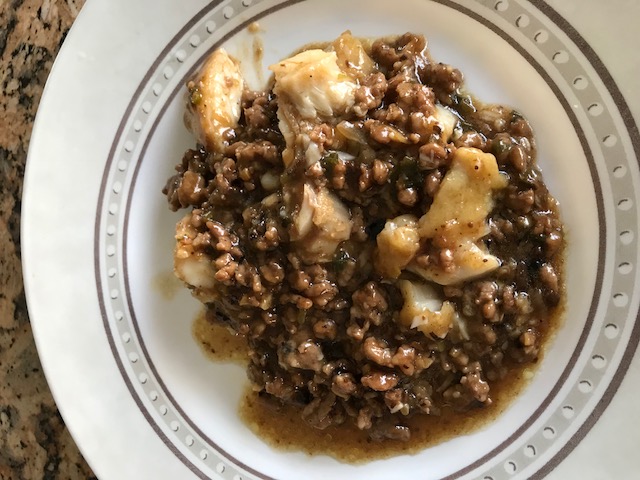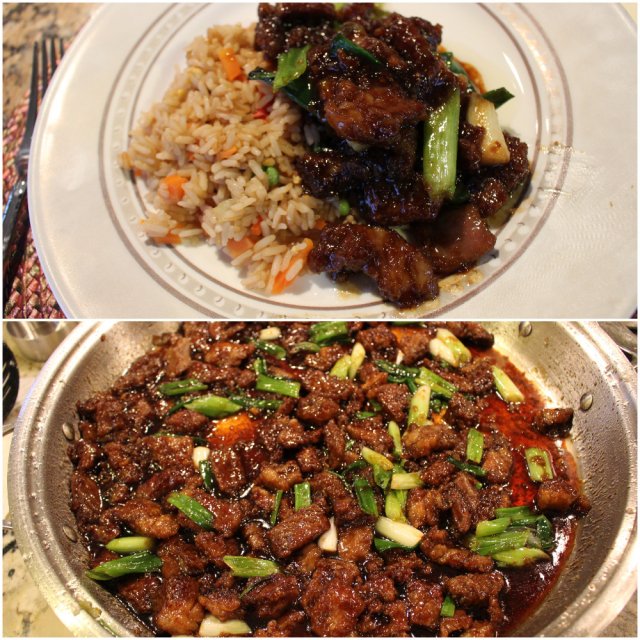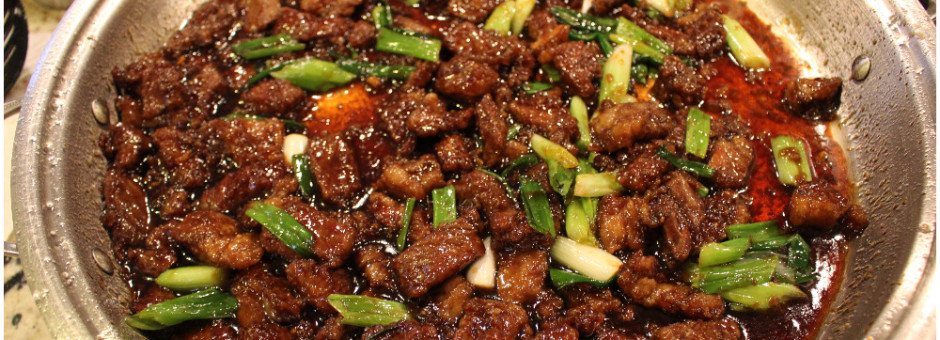Asian Cuisine
Country Style Beef Ribs, Mongolian Beef Style...Browned, Simmered, glazed in an Electric Frying Pan
These popular favorites were available throughout Boston and much of New England and usually made there with ground pork, fermented black beans, minced garlic and ginger, scallions, sherry, soy, and more options in a rich dark sauce that includes sherry and soy. Although classically finished with scrambled egg, optional for others. Neither contain lobster but “featured” in Lobster Cantonese.
This incredible bold sauce can accompany poultry, seafood, vegetables, shrimp, rice, soft or crispy Chinese noodles.
Outside New England, Chinese restaurants mostly offered bland Lobster Sauce with a delicate clear broth. My favorite dark and bold versions are rarely found. When we relocated, I went on a mission to learn how to cook “Boston” style Lobster Sauce.
See below for my results. Enjoy.
Boston Style Lobster Sauce…
With Flakey Seafood
.jpg)
As discussed above, Lobster sauce is available in Boston and most of New England. This recipe is made with ground pork flavored with fermented black beans, garlic, ginger, and scallions in a hardy dark sauce that includes sherry, soy. It is classically finished with scrambled egg; some consider it optional.
Fermented Black Beans are whole soybeans that are salted and fermented. They are usually found imported in cellophane bags and jars in some Asian grocery stores, also at Amazon. You may be able to find jars of black bean paste locally with added ingredients combined. I find contents unacceptably salty.
Once ingredients are gathered and prepped, cooking times for Lobster Sauce is quick.
Remember, you can lighten up on recommended low salt soy sauce and correct for taste later.
Fermented Black Bean Sauce
Ingredients:
Spice mixture
- 2 generous tablespoons fermented black beans
- 4 larger cloves garlic minced.
- 3 quarter size slices fresh ginger minced.
- 4 small scallions chopped fine, about 1/3rd cup
- Cooking oil
Ground Pork
- ½ pound ground pork
Thickener
- 2 tablespoons cornstarch
- ¼ cup water
- Drizzle of oil
Sauce
- 2 tablespoons dry sherry
- 2-3 tablespoons low salt soy sauce
- ½ teaspoon sugar
- 1 cup chicken broth
- 2 tablespoons cornstarch
- ¼ cup water
- Drizzle of oil
Optional Seafood
- A pound of flakey seafood
Preparation, about an hour before cooking, rinse fermented black beans in a strainer. Place in a cup partly covered with water. Beans will absorb water and lightly soften them.
Sautee lightly flowered seafood until just cooked through. Keep warm.
When ready to cook, coarsely chop fermented black beans. Spread them in the frying pan with garlic, ginger, chopped scallions and about 2 tablespoons of cooking oil. Sauté while stirring for a about a minute.
Add ground pork. Use the edge of a spatula to break pork apart throughout while stirring. When browned stir in sauce ingredients.
Prepare thickener, cornstarch and set aside.
Bring lobster sauce to a simmer. Gradually thicken as desired.
Place over seafood.
Serve with plain or fried rice, soft or hard noodles.
- 1 ½ pounds extra-large shrimp, preferably wild caught
- Lobster Sauce, Recipe Above
- Cooking oil

- Lobster Sauce, Recipe Above
- 1-pound fillet of sole or tilapia
- Flour for dredging
- Salt and pepper
- Cooking oil
- 1/2 teaspoon salt
- 1 Tablespoon dry sherry
- 1/8 teaspoon black pepper
- 1 egg white well beaten
- 1 1/2 tablespoon cornstarch
- 1 tablespoon oil
- 2 ¼ pounds boneless and skinless chicken breasts
- 1 teaspoons Kosher salt
- 2 tablespoons dry sherry
- 2 large egg whites
- 2 tablespoons corn starch
- 2 tablespoons vegetable oil
- 1 bunch scallions
- 1 ½ tablespoons minced ginger
- 2 tablespoons finely chop garlic (about 4 cloves)
- 2 Tablespoons fermented black beans
- vegetable oil as needed
- 3 Tablespoons low sodium soy sauce
- 3 tablespoons dry sherry
- 2 teaspoons sugar
- 1 ½ cup water
- 2 tablespoons cornstarch
- ¼ cup water
.jpg)
- 2 Tablespoons fermented black beans
- 1 ½ tablespoons minced ginger
- 2 tablespoons finely chop garlic (about 4 cloves)
- vegetable oil as needed
- 3 Tablespoons low sodium soy sauce
- 3 tablespoons dry sherry
- 2 teaspoons sugar
- 1 ½ cup water
- 2 tablespoons cornstarch
- ¼ cup water
- 10-ox package frozen broccoli florets
- 14.5 oz. can chicken broth
- 2 pounds salmon

Once introduced to Mongolian Beef at one of the nation’s best known Chinese restaurant chains, home chefs went on missions to develop copycat recipes. Many recipes are similar even identical. Sauce’s ingredients are often found in Chinese cooking, scallions, garlic, ginger, soy sauce, cornstarch, and brown sugar.
The dish is also relatively simple. Sauce requires minimal prepping and is systematically cooked in a single pan. Beef is sliced, lightly coated with corn starch, and rested to seal in flavors while helping beef crisp as recommended. Meat is seared, combined with sauce, glazed, then garnished with pre-cooked scallions. Dish is simply delicious.
The secret to great Mongolian beef is to quick sear tender beef strips all around in small batches making sure centers are cooked tender and moist. Overcooking will result in dry tough beef.
I have tested my Mongolian Beef recipe with different cuts of beef. Although somewhat tougher, Flank is perhaps most common. Sliced thin and cut against its grain helps make it less chewy.
My favorite is “choice” Rib-Eye steak. It is moderately priced with sufficient marbling for natural tenderness. It can be sliced a little thicker to help prevent accidently overcooking through.
I usually cut strips about 1” wide by 2 ½” long, ¼ to 3/8 inch for tender cuts.
Friends have shared surprisingly great results using economical shaved beef.
For convenance, I’m including two sets of ingredients proportioned to generously serve 4 or 6 guests.
For Tougher Cuts of Beef, please see my recipe below using a slightly modified version of Irene Kuo’s “Slippery Coating for Beef” featured it in her incredible Chinese cookbook, “The Keys to Chinese Cooking”. Cornstarch is dissolved with water and mixed with soy sauce. Magically coating and resting beef with this mixture turns tough beef tender; second version below. Somewhat borderline tender, flank can also benefit from slippery coating.
Serves 4
Ingredients:
- 2 pounds of tender beef after trimming
- ½ cup cornstarch
- 1 package scallions
- 1 1/2 tablespoon smashed/minced ginger.
- 2 tablespoon minced garlic
- 3/4 cup lite soy sauce low sodium
- ¾ cup water
- 1 cup dark brown sugar lightly tapped.
- Red pepper flakes, optional
Serves 6
Ingredients:
- 3 pounds of tender beef after trimming
Coating for tender cuts
- 3/4 cup cornstarch
Mongolian Sauce
- 1 package scallions, 2 if small
- 2 tablespoons smashed/minced ginger.
- 3 tablespoon minced garlic
- 1 cup lite soy sauce low sodium
- 1 cup water
- 1 1/2 cup dark brown sugar, lightly tapped
- Red pepper flakes, optional
Cut beef against its grain into convenient size strips, about an inch wide, 2 ½ inch long, ¼ to 3/8 inch thick. Can be done well ahead, even a day ahead and refrigerated.
Trim scallions, rough bottoms, tips, and any wilted skins. Cut diagonally in one-inch lengths.
Peel ginger and cut into quarter size pieces. Cover with wax paper and smash with a cleaver or mallet and chop.
Finely chop garlic.
Coating, place beef slices in a baking pan with sides or in a bowl. Sprinkle with all the corn starch a little at a time while flipping the meat. Make sure beef is coated on all sides. Set aside for at least 15 minutes.
In a pot, sauté scallions in a small amount of oil over medium-low heat for about 30 seconds. Remove to a plate or bowl.
Add ginger and garlic in the same pot, stir for about 30 seconds. Add the soy sauce, water, and dark brown sugar. Bring to a boil, lower heat, and simmer until sauce starts to thicken. Remove from heat.
Cook beef in a large pan over high heat (can be done in batches). Add enough cooking oil to just cover the beef. Best if beef is quick cooked crispy but more important not to overcook, have some pink inside; beef will be warmed again with sauce. Temporarily remove beef and discard cooking oil.
Add cooked beef to the pan with the sauce. Stir very briefly to heat the sauce and glaze the beef
Finish the dish with the scallions. If desired, you can also add a little heat with red pepper flakes to taste.
We serve it next to a scoop of Chinese steamed rice. Another very easy option, serve it with packed and
prepared frozen fried rice. Follow package heating directions.
- 2 1/2 Tablespoons cornstarch
- 4 tablespoons water
- 1 1/2 tablespoons soy sauce
- 2 tablespoons cooking oil, i.e. vegetable or canola
Braised Short Ribs Mongolian Beef Style
-9bf31.jpg)
This is a variation of my Mongolian Beef recipe above. Both are flavored and glazed with our sweet and savory Mongolian sauce. This adaption replaces thin sliced crispy beef with Beef Short ribs that are browned and slow cooked at a modest 275° with Mongolian sauce in a Dutch oven. Ribs fall off their bones and become very tender in about 2 hours.
Sauce includes scallions, minced ginger, garlic, soy sauce, brown sugar, slightly thinned with water.
Ribs are finished single layer in an open roasting pan topped with sauce. Temperature is increased to 350°direct heat. Results, ribs are fork tender and glazed. Sauce is slightly thickened with incredible complex and sweetened Asian flavors.
Ribs can be served as an appetizer, family style placed over Chinese noodles, rice, and/or roasted vegetables like carrots tossed with olive oil and garlic. Plan on 2 short ribs per person, about 3 pounds for four hungry adults.
Ingredients:
- 8-10 short ribs, about 3 pounds
- Salt and pepper
- 1 package scallions (5.5 oz)
Sauce
- 2 tablespoon minced ginger
- 2 tablespoon minced garlic
- 1 cup lite soy sauce low sodium
- 1 cup water
- 1 1/2 cup dark brown sugar, lightly tapped
- Red pepper flakes, optional
Dry ribs with paper towel. Lightly sprinkle with salt and black pepper.
Preheat oven to 275° direct heat.
Remove root tips of scallions. Cut stalks diagonally in one-inch lengths.
Brown and lightly sear ribs on all sides with cooking oil, about 8-10 minutes per batch. A Dutch oven or similar pan that can go from stovetop to oven with cover is most convenient.
Remove short ribs. Skim and discard all but a couple of tablespoons of fat. Try to preserve flavor bits.
Sauté scallions in medium-low heat in the same pot for about 30 seconds. Remove to a plate. Add ginger and garlic in the same pot; stir for about 30 seconds. Add the soy sauce, water, and dark brown sugar. Bring to a light simmer. Remove from heat. Stir sauce.
Coat ribs and position them flat on the bottom of the pot as best as you can. Cover and place in the middle of the oven. After about an hour, flip ribs over and continue roasting. When meat has fallen off the bone, about another half hour remove pot.
Place meat single layer in an open roasting pan. Pour sauce over. Raise oven to 350° direct heat. Every 15 minutes flip ribs. Sauce will thicken to a light sauce, ribs glazed, and beef will have the consistency of pulled pork.
Toss with cooked scallions and serve.
Country Style Beef Ribs, Mongolian Beef Style…
Browned, Simmered, and glazed in an Electric Frying Pan
-c20ad.jpg)
This is another variation of Mongolian Beef. Country style beef ribs are smaller than short ribs, have less fat, cooks quicker and is conveniently cooked entirely in an electric frying pan.
As above, sauce includes scallions, minced ginger, garlic, soy sauce, brown sugar, slightly thinned with water.
Country style ribs can be purchased with or without bone; pictured without.
Dry ribs with paper towel. Lightly sprinkle with salt and black pepper.
Remove root tips of scallions. Cut stalks diagonally in one-inch lengths.
Lightly sear ribs on all sides with cooking oil in a large electric frying pan; Remove short ribs.
Prepare Mongolian Sauce. Sauté scallions in medium-low heat in the same pot for about 30 seconds. Remove to a plate. Add ginger and garlic in the same pot; stir for about 30 seconds. Add the soy sauce, water, and dark brown sugar. Stir sauce.
Heat to a low simmer. Toss ribs with the sauce and maintain the simmer. Periodically stir ribs. When ribs are tender, remove cover and thicken sauce enough to coat and lightly glaze ribs.
Toss with cooked scallions and serve over rice.

